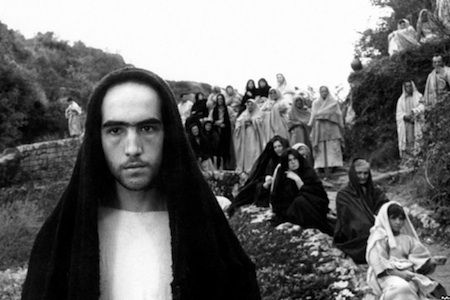With Easter approaching, I made this tribute to what I consider to be the greatest screen version of the life of Jesus Christ, The Gospel According to Saint Matthew by Pier Paolo Pasolini. Why is it the best? Because for me it embodies what I consider to be the the most vital principles of Christianity: humility, humanity and a profound sense of the transformative. It embodies these qualities not just in its content, but in its very cinematic fabric.
Its humility shines in its modest surfaces, so far removed from the slick seal-of-quality production values typical of Biblical movies, from Cecil B. DeMille to Mel Gibson. Shot in gritty black-and-white with handheld cameras, the film doesn’t try to impress with a polished, packaged, Sunday School-ready presentation of Jesus’ life and teachings, but something raw that seems to spring from the rugged terrain depicted in the film. That unvarnished quality gives it an energy and freshness unlike most other depictions of Christ. Its modest means remind us that the son of God lived modestly all of his short life. Here’s a film that finds his earthly existence at ground level.
Its humanity is evident in how Pasolini films his cast, largely a motley group of non-professionals and local residents of the southern Italian locations where the film was shot. Their physiognomies have the bracing genuineness that one finds in Fellini movies, though with less a sense of caricature; Pasolini’s faces are less overt in the meanings they convey, and contain more of an inner mystery. Gospel in particular revels in faces, with nearly forty percent of its run-time devoted to facial close-ups.
It’s the beauty of Pasolini’s faces that I emphasize in this three-part video. The first part encompasses every close-up in the film, playing them in sequence at 300 times normal speed to give a sense of one face blurring into the next, all humanity fused into one. The second part focuses on the film’s many shot-reverse shot sequences (as well as sequences that involve multiple characters responding to each other, and there’a also a breakdown of the long sequence where Christ speaks in different locations and times of day). Shot-reverse shot is a critical device in the film. The film’s dramatic scenes are hardly exposited through medium shots or elaborate staging. Instead we see people talking and listening through shot-reverse shots, depicting the life of Christ and the Gospel of Matthew as a series of dialogues and debates.
[iframe width=”640″ height=”360″ src=”http://www.youtube.com/embed/DZHtLzO-mbA” frameborder=”0″ allowfullscreen]
The last part of the video touches on the film’s transformative aspects, which I find the most profoundly mysterious and unsettling. This particular moment is the one that has stayed with me from the first time I saw the film. The shocking first appearance of the leper, in a long shot that doesn’t flinch from his appearance, taking in his suffering. And then the miracle; he’s suddenly free of his affliction with blindsiding abruptness through what is obviously a cinematic trick. It’s a trick that instilled outrage the first time I watched it—you mean he was wearing a mask, he wasn’t real? I had so believed that Pasolini had found an actual person suffering from that illness, and was left reeling to make sense of what I had just seen, and what to believe. That “what to believe” goes straight to the power of the Gospels, with its story of a life so miraculous and full of beauty that it rings with truth, even as it defies what we in the present experience as real. That defiance of reality, in all of its inequality, hypocrisy, corruption and unacceptable convention, is what gives the film’s vision of Jesus its gospel power.
Kevin B. Lee is a filmmaker, critic and video essayist. Follow him on Twitter.




